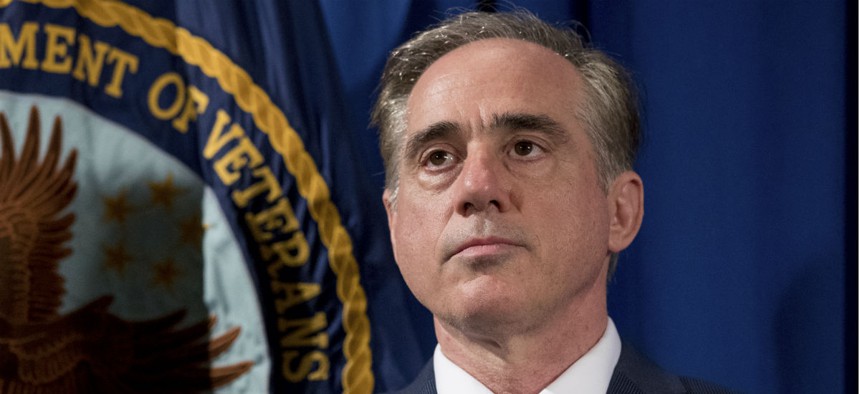
VA Secretary David Shulkin said the department should stop supporting "maintenance of buildings we don’t need, and we want to reinvest that in buildings we know have capital needs." Andrew Harnik/AP
VA Considers Hundreds of Building Closures, but Focus Is Not on Medical Facilities
Idea traces back to conservative groups now affiliated with Trump administration.
The Veterans Affairs Department has hundreds of unused or rarely-used buildings, the agency’s leader told Congress this week, saying he wants to work with lawmakers to unload them.
VA Secretary David Shulkin made waves Wednesday for comments during a House Veterans Appropriations Subcommittee hearing in which he said VA had identified more than 1,100 department-owned buildings that were either vacant or underutilized. Shulkin quickly clarified to stakeholders, however, he was referring primarily to non-medical buildings the department holds as part of its extensive nationwide network.
Garry Augustine, executive director of Disabled American Veterans, a group with more than 1.3 million members, said he spoke to Shulkin Wednesday evening and the secretary clarified he was not referring to medical facilities. Augustine, whose group in recent months has joined virtually all veterans service organizations in calling for a strengthened VA rather than cuts to resources or shifts toward privatization, said he would support selling off buildings that are of virtually no use to the department.
“If they have buildings that are empty and not being used but they still have to pay for their maintenance and upkeep, I think that’s ridiculous,” Augustine said. “It’s long overdue.”
Still, the process could prove difficult for VA to oversee. Shulkin said VA has identified 430 vacant buildings and 735 he called underutilized. He said he would consider a process similar to the Defense Department’s Base Realignment and Closure procedure, or something else that would also require congressional approval.
“We want to stop supporting our use of maintenance of buildings we don’t need, and we want to reinvest that in buildings we know have capital needs,” Shulkin said.
The idea traces its roots back to the George W. Bush administration; a VA spokesperson said the department has closed 1,059 "structures of all types" since 2004. During the Obama administration, then-Secretary Eric Shinseki complained his department was forced to maintain buildings it no longer needed. Shinseki led an effort to convert such facilities into shelters for homeless veterans. The support for closures picked up momentum after a contingent of the congressionally chartered Commission on Care released its own report on fixing VA care, pointing to a VA version of BRAC as a necessary way to increase efficiency. One member of that group, Darin Selnick, is now a senior adviser to Shulkin.
Selnick refused to sign the commission’s final report, saying the proposed sweeping changes to the Veterans Health Administration did not go far enough. As a first step toward “bold transformation,” Selnick and other who signed onto this “strawman report” proposed a systematic closure of facilities deemed underutilized or obsolete. Subsequently, the report said -- if veteran choice dictated it -- “the long-term goal of the transformation is the total transition to community care.”
Selnick previously worked at Concerned Veterans for America, a conservative group that has for years pushed for more private care. Dan Caldwell, CVA’s policy director, applauded Shulkin for taking “tough steps” to lead a “bold effort” toward VA efficiency.
“Revelations that the VA is operating hundreds of empty buildings make it difficult to justify why the VA’s budget is increased without question every year,” Caldwell said. “A more efficient, accountable VA means better care for veterans.”
The VA spokesperson said the department is constantly looking to identify buildings to close.
"Looking ahead, VA will continue to assess our infrastructure and collaborate with Congress to find ways to realign VA's capital assets, and dispose of those buildings we don’t need and reinvest in the buildings we do need,” the spokesperson said.
After the Commission on Care issued its final report, Rep. Cathy McMorris Rodgers, R-Wash., a member of House leadership, introduced draft legislation similar to Selnick’s and CVA’s proposed reforms. Part of that proposal would have created an independent commission to identify underutilized VA facilities for closure, while giving Congress final veto power. The commission would have been tasked with ensuring that veterans located in areas with scheduled facility closures would not experience diminished access to care.
At Wednesday’s hearing, Rep. Jeff Fortenberry, R-Neb., signaled how difficult that process could be.
“Don’t ever use the term BRAC because it brings up a lot of bad memories,” Fortenberry told Shulkin. “You automatically set yourself up for a lot of controversy.”
DAV’s Augustine did not outright reject the possibility of closing medical facilities, noting there are some hospitals that only serve a handful of patients.
“We’d like to know more about the plan for what they are going to do with those patients” served by those facilities, he said.







